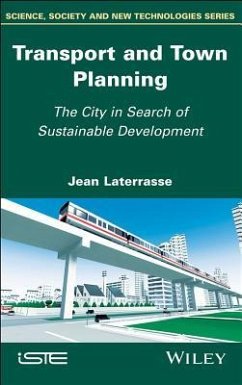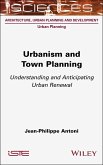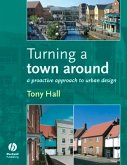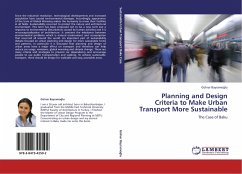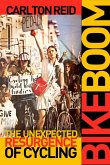Schade – dieser Artikel ist leider ausverkauft. Sobald wir wissen, ob und wann der Artikel wieder verfügbar ist, informieren wir Sie an dieser Stelle.
- Gebundenes Buch
- Merkliste
- Auf die Merkliste
- Bewerten Bewerten
- Teilen
- Produkt teilen
- Produkterinnerung
- Produkterinnerung
In a context where climate change urgently requires us to alter our paradigms, this book explores the possibilities of cities that are both more energy efficient and more respectful of the environment. Based on the observation that urban planning has been detrimentally affected by the compartmentalization of knowledge and practices, this book is conceived as a dialog between transport and urban planning on the one hand, and between engineering and social science on the other. Systemic analysis and a historical approach, integrating the teachings of the last two centuries, constitute at the…mehr
Andere Kunden interessierten sich auch für
![Urbanism and Town Planning Urbanism and Town Planning]() Urbanism and Town Planning164,99 €
Urbanism and Town Planning164,99 €![Turning a Town Around Turning a Town Around]() Anthony HallTurning a Town Around106,99 €
Anthony HallTurning a Town Around106,99 €![Bolton as It is and as It Might Be: Six Lectures Delivered Under the Auspices of the Bolton Housing and Town Planning Society Bolton as It is and as It Might Be: Six Lectures Delivered Under the Auspices of the Bolton Housing and Town Planning Society]() Thomas Hayton MawsonBolton as It is and as It Might Be: Six Lectures Delivered Under the Auspices of the Bolton Housing and Town Planning Society31,99 €
Thomas Hayton MawsonBolton as It is and as It Might Be: Six Lectures Delivered Under the Auspices of the Bolton Housing and Town Planning Society31,99 €![Town Planning into the 21st Century Town Planning into the 21st Century]() Andy Blowers / Bob Evans (eds.)Town Planning into the 21st Century322,99 €
Andy Blowers / Bob Evans (eds.)Town Planning into the 21st Century322,99 €![Planning and Design Criteria to Make Urban Transport More Sustainable Planning and Design Criteria to Make Urban Transport More Sustainable]() Gülnar Bayramo luPlanning and Design Criteria to Make Urban Transport More Sustainable38,99 €
Gülnar Bayramo luPlanning and Design Criteria to Make Urban Transport More Sustainable38,99 €![Concerning Town Planning Concerning Town Planning]() Concerning Town Planning30,99 €
Concerning Town Planning30,99 €![Bike Boom Bike Boom]() Carlton ReidBike Boom53,99 €
Carlton ReidBike Boom53,99 €-
-
-
In a context where climate change urgently requires us to alter our paradigms, this book explores the possibilities of cities that are both more energy efficient and more respectful of the environment. Based on the observation that urban planning has been detrimentally affected by the compartmentalization of knowledge and practices, this book is conceived as a dialog between transport and urban planning on the one hand, and between engineering and social science on the other. Systemic analysis and a historical approach, integrating the teachings of the last two centuries, constitute at the methodological level the framework in which this dialog unfolds. Based on examples of good practice, Transport and Town Planning identifies an effective set of levers of action and proposes an original method to guide and accompany urban transition with a large share of the initiative reserved for the actors concerned.
Produktdetails
- Produktdetails
- Verlag: Wiley
- Seitenzahl: 328
- Erscheinungstermin: 21. Mai 2019
- Englisch
- Abmessung: 239mm x 160mm x 23mm
- Gewicht: 635g
- ISBN-13: 9781786303295
- ISBN-10: 1786303299
- Artikelnr.: 55516897
- Herstellerkennzeichnung
- Libri GmbH
- Europaallee 1
- 36244 Bad Hersfeld
- gpsr@libri.de
- Verlag: Wiley
- Seitenzahl: 328
- Erscheinungstermin: 21. Mai 2019
- Englisch
- Abmessung: 239mm x 160mm x 23mm
- Gewicht: 635g
- ISBN-13: 9781786303295
- ISBN-10: 1786303299
- Artikelnr.: 55516897
- Herstellerkennzeichnung
- Libri GmbH
- Europaallee 1
- 36244 Bad Hersfeld
- gpsr@libri.de
Jean Laterrasse worked for 15 years as a Professor at Paris Est University in France, where he directed the "Ville mobilité transport" laboratory and a Master's program for engineers and urban planners. He is currently scientific advisor at the Institut pour la transition energétique de la ville Efficacity.
Preface xi
Chapter 1. City and Complexity: How to Untangle the Skein? 1
1.1. Systemic thinking and its historical context 1
1.2. The system approach 3
1.3. Analytical and systemic methods are complementary rather than opposed
4
1.4. Transdisciplinarity of the concept of system and presentation of a
typology of complexity 5
1.5. The concept of variety 10
1.6. Keys to analyzing a system: functions and structures 12
1.6.1. The concept of function 13
1.6.2. The concept of structure 15
1.7. From description to analysis and action: the example of flowcharts 16
1.8. Concept of model and systemic modeling 19
1.9. An application of systemic analysis: study of the relationships
between transport networks and territory 21
1.10. Action as a method of knowledge 25
Chapter 2. Town Planning and Urban Pattern: the Emergence of Circulatory
Function 29
2.1. The first urban fabrics: two founding patterns 29
2.2. Advent of circulatory function 31
2.2.1. Powerful changes implemented 31
2.2.2. Cerdà, the theoretician 32
2.2.3. Haussmann, the realist 33
2.3. The effects of the mechanization of modes of transport 35
2.3.1. The linear city of Arturo Soria y Mata 36
2.3.2. Garden cities 37
2.4. Urban transport: a chaotic development 39
2.4.1. A public interest service 39
2.4.2. Mechanization 40
2.5. Advent of electric traction and its success following the construction
of the Paris subway 41
2.5.1. The accident "founder" of the Couronnes station 42
2.5.2. The first wave of automation 43
2.5.3. The triptych of innovation: technologies, organization and
professions 44
2.6. The tramway: from its disappearance in France to its rebirth 45
2.6.1. The development period 46
2.6.2. Decline of the tramway 47
2.6.3. The rebirth 49
2.7. The automobile city 50
2.7.1. Progressive town planning and the functional specification of spaces
50
2.7.2. The convergence between functionalism and naturalism 52
2.8. Towards the public transport city? 54
2.8.1. The "omnipresent automobile" in question 54
2.8.2. "Transport-oriented development" 55
2.8.3. The end of utopias? 57
Chapter 3. Building of New Towns: an Attempt at Linking Transport Networks
to Urban Planning 59
3.1. From imaginary new towns to their achievement 60
3.1.1. The initial project 60
3.1.2. A new territorial organization 65
3.1.3. The structuring role of big transportation infrastructures 66
3.1.4. A period rich in innovations 66
3.1.5. An undeniable success? 67
3.2. The case of Marne-la-Vallée 68
3.2.1. Marne-la-Vallée's entry into the regional space 68
3.2.2. The evolution of the overall administrative and institutional
framework of new towns 72
3.2.3. The specific institutional organization of Marne-la-Vallée 74
3.3 A mixed report 77
3.3.1. Population growth stimulated by housing construction 77
3.3.2. Activities, employment and job/active population balance in new
towns 80
3.3.3. The importance of areas reserved for activities. 82
3.3.4. Employment location areas and source of active population 83
3.3.5. Internal circulation in Marne-la-Vallée new town - the most
overlooked of urban planning 84
3.3.6. Motorization and servicing of the population by public transport 87
3.3.7. Gradual saturation of the main road network 88
3.3.8. What lessons can be drawn? 90
Chapter 4. Models and Definitions: Changing the Paradigm 93
4.1. The mobility model that was developed in France from the 1950s 95
4.1.1. Mobility and urban sprawl 96
4.1.2. Mobility and land market 98
4.1.3. Characteristics specific to France? 102
4.1.4. Planning "formatted" by the use of cars 104
4.2. A model whose coherence and sustainability are undermined 107
4.2.1. Lessons of the subprime crisis 110
4.2.2. Land rents create shortages 113
4.2.3. A system that aggravates socio-spatial disparities 115
4.2.4. The forms taken by urbanization in France present real advantages
116
4.3. Back to town planning 117
4.3.1. Two essential models 118
4.3.2. From models to concrete cities 121
4.3.3. Town planning as a coherent layout of places, functions, structures,
representations and forms 123
Chapter 5. Good Practices and Levers of Action 125
5.1 Influence of urban metrics 125
5.1.1. Urban form: what is it all about? 125
5.1.2. Reflecting on real cities and choosing a systematic approach 129
5.2. Innovations and good practices 130
5.2.1. European cities 132
5.2.2. The North American case 146
5.3. Major levers of action 159
5.3.1. Land use planning and transport networks 160
5.3.2. Transport-specific measures 164
5.3.3. Tariff and regulatory measures 170
5.3.4. What should be expected of new technologies? 172
Chapter 6. What if the 21st Century was the Century of Suburbs? 177
6.1. French cities: undeniable progress but a long way to go 177
6.1.1. Legislative progress 178
6.1.2. Tangible results, but shortcomings and strong resistance 179
6.2. Suburbs: characteristics, challenges and future prospects 181
6.2.1. History and semantics of the suburb 182
6.2.2. The suburbs change dimension with the industrial revolution 183
6.2.3. From workers' houses to the construction of large complexes 184
6.2.4. Transport in difficulties. 185
6.2.5. A real potential for sustainable urban development 189
6.3. A prospective reflection by 2050 190
6.3.1. The context of the study 190
6.3.2. Assumptions adopted for establishing a "target scenario" 192
6.3.3. Method used for the simulation of the target scenario 193
6.3.4. Achieved results 196
6.3.5. Elements concerning the financial equation 197
6.4. Transport and town planning articulation at the local level: the case
of the southern suburbs of Ile-de-France 198
6.4.1. The Trans Val-de-Marne 199
6.4.2. Setting up of the line 183 dedicated bus lane 202
6.5. Significance and diversity of local approaches 207
6.5.1. The municipalities that objected 208
6.5.2. Municipalities that might have wished to do better 211
6.5.3. Municipalities that succeeded in making dedicated lanes a lever for
urban restructuring: the case of Vitry-sur-Seine 215
6.5.4. What lessons? 222
Chapter 7. Methods and Tools for Urban Transition 229
7.1. Urban transition and prospective 229
7.2. An iterative and interactive approach 231
7.3. Backcasting and forecasting approaches 233
7.4. Development of a conceptual framework for the assessment and
monitoring of the transition process (backcasting approach) 235
7.4.1. Importance of territorial diagnosis 235
7.4.2. The establishment of a complete and coherent set of indicators 236
7.4.3. Advantages of the proposed conceptual framework 244
7.5. Assessment methods 245
7.5.1. Methods based on life cycle assessment (LCA) 245
7.5.2. Socio-economic methods 254
7.6. Transport models and the difficult question of demand forecast 263
7.6.1. Rebound phenomenon 263
7.6.2. Transport models 266
7.6.3. Land use models 270
Conclusion 279
Glossary 285
References 289
Index 309
Chapter 1. City and Complexity: How to Untangle the Skein? 1
1.1. Systemic thinking and its historical context 1
1.2. The system approach 3
1.3. Analytical and systemic methods are complementary rather than opposed
4
1.4. Transdisciplinarity of the concept of system and presentation of a
typology of complexity 5
1.5. The concept of variety 10
1.6. Keys to analyzing a system: functions and structures 12
1.6.1. The concept of function 13
1.6.2. The concept of structure 15
1.7. From description to analysis and action: the example of flowcharts 16
1.8. Concept of model and systemic modeling 19
1.9. An application of systemic analysis: study of the relationships
between transport networks and territory 21
1.10. Action as a method of knowledge 25
Chapter 2. Town Planning and Urban Pattern: the Emergence of Circulatory
Function 29
2.1. The first urban fabrics: two founding patterns 29
2.2. Advent of circulatory function 31
2.2.1. Powerful changes implemented 31
2.2.2. Cerdà, the theoretician 32
2.2.3. Haussmann, the realist 33
2.3. The effects of the mechanization of modes of transport 35
2.3.1. The linear city of Arturo Soria y Mata 36
2.3.2. Garden cities 37
2.4. Urban transport: a chaotic development 39
2.4.1. A public interest service 39
2.4.2. Mechanization 40
2.5. Advent of electric traction and its success following the construction
of the Paris subway 41
2.5.1. The accident "founder" of the Couronnes station 42
2.5.2. The first wave of automation 43
2.5.3. The triptych of innovation: technologies, organization and
professions 44
2.6. The tramway: from its disappearance in France to its rebirth 45
2.6.1. The development period 46
2.6.2. Decline of the tramway 47
2.6.3. The rebirth 49
2.7. The automobile city 50
2.7.1. Progressive town planning and the functional specification of spaces
50
2.7.2. The convergence between functionalism and naturalism 52
2.8. Towards the public transport city? 54
2.8.1. The "omnipresent automobile" in question 54
2.8.2. "Transport-oriented development" 55
2.8.3. The end of utopias? 57
Chapter 3. Building of New Towns: an Attempt at Linking Transport Networks
to Urban Planning 59
3.1. From imaginary new towns to their achievement 60
3.1.1. The initial project 60
3.1.2. A new territorial organization 65
3.1.3. The structuring role of big transportation infrastructures 66
3.1.4. A period rich in innovations 66
3.1.5. An undeniable success? 67
3.2. The case of Marne-la-Vallée 68
3.2.1. Marne-la-Vallée's entry into the regional space 68
3.2.2. The evolution of the overall administrative and institutional
framework of new towns 72
3.2.3. The specific institutional organization of Marne-la-Vallée 74
3.3 A mixed report 77
3.3.1. Population growth stimulated by housing construction 77
3.3.2. Activities, employment and job/active population balance in new
towns 80
3.3.3. The importance of areas reserved for activities. 82
3.3.4. Employment location areas and source of active population 83
3.3.5. Internal circulation in Marne-la-Vallée new town - the most
overlooked of urban planning 84
3.3.6. Motorization and servicing of the population by public transport 87
3.3.7. Gradual saturation of the main road network 88
3.3.8. What lessons can be drawn? 90
Chapter 4. Models and Definitions: Changing the Paradigm 93
4.1. The mobility model that was developed in France from the 1950s 95
4.1.1. Mobility and urban sprawl 96
4.1.2. Mobility and land market 98
4.1.3. Characteristics specific to France? 102
4.1.4. Planning "formatted" by the use of cars 104
4.2. A model whose coherence and sustainability are undermined 107
4.2.1. Lessons of the subprime crisis 110
4.2.2. Land rents create shortages 113
4.2.3. A system that aggravates socio-spatial disparities 115
4.2.4. The forms taken by urbanization in France present real advantages
116
4.3. Back to town planning 117
4.3.1. Two essential models 118
4.3.2. From models to concrete cities 121
4.3.3. Town planning as a coherent layout of places, functions, structures,
representations and forms 123
Chapter 5. Good Practices and Levers of Action 125
5.1 Influence of urban metrics 125
5.1.1. Urban form: what is it all about? 125
5.1.2. Reflecting on real cities and choosing a systematic approach 129
5.2. Innovations and good practices 130
5.2.1. European cities 132
5.2.2. The North American case 146
5.3. Major levers of action 159
5.3.1. Land use planning and transport networks 160
5.3.2. Transport-specific measures 164
5.3.3. Tariff and regulatory measures 170
5.3.4. What should be expected of new technologies? 172
Chapter 6. What if the 21st Century was the Century of Suburbs? 177
6.1. French cities: undeniable progress but a long way to go 177
6.1.1. Legislative progress 178
6.1.2. Tangible results, but shortcomings and strong resistance 179
6.2. Suburbs: characteristics, challenges and future prospects 181
6.2.1. History and semantics of the suburb 182
6.2.2. The suburbs change dimension with the industrial revolution 183
6.2.3. From workers' houses to the construction of large complexes 184
6.2.4. Transport in difficulties. 185
6.2.5. A real potential for sustainable urban development 189
6.3. A prospective reflection by 2050 190
6.3.1. The context of the study 190
6.3.2. Assumptions adopted for establishing a "target scenario" 192
6.3.3. Method used for the simulation of the target scenario 193
6.3.4. Achieved results 196
6.3.5. Elements concerning the financial equation 197
6.4. Transport and town planning articulation at the local level: the case
of the southern suburbs of Ile-de-France 198
6.4.1. The Trans Val-de-Marne 199
6.4.2. Setting up of the line 183 dedicated bus lane 202
6.5. Significance and diversity of local approaches 207
6.5.1. The municipalities that objected 208
6.5.2. Municipalities that might have wished to do better 211
6.5.3. Municipalities that succeeded in making dedicated lanes a lever for
urban restructuring: the case of Vitry-sur-Seine 215
6.5.4. What lessons? 222
Chapter 7. Methods and Tools for Urban Transition 229
7.1. Urban transition and prospective 229
7.2. An iterative and interactive approach 231
7.3. Backcasting and forecasting approaches 233
7.4. Development of a conceptual framework for the assessment and
monitoring of the transition process (backcasting approach) 235
7.4.1. Importance of territorial diagnosis 235
7.4.2. The establishment of a complete and coherent set of indicators 236
7.4.3. Advantages of the proposed conceptual framework 244
7.5. Assessment methods 245
7.5.1. Methods based on life cycle assessment (LCA) 245
7.5.2. Socio-economic methods 254
7.6. Transport models and the difficult question of demand forecast 263
7.6.1. Rebound phenomenon 263
7.6.2. Transport models 266
7.6.3. Land use models 270
Conclusion 279
Glossary 285
References 289
Index 309
Preface xi
Chapter 1. City and Complexity: How to Untangle the Skein? 1
1.1. Systemic thinking and its historical context 1
1.2. The system approach 3
1.3. Analytical and systemic methods are complementary rather than opposed
4
1.4. Transdisciplinarity of the concept of system and presentation of a
typology of complexity 5
1.5. The concept of variety 10
1.6. Keys to analyzing a system: functions and structures 12
1.6.1. The concept of function 13
1.6.2. The concept of structure 15
1.7. From description to analysis and action: the example of flowcharts 16
1.8. Concept of model and systemic modeling 19
1.9. An application of systemic analysis: study of the relationships
between transport networks and territory 21
1.10. Action as a method of knowledge 25
Chapter 2. Town Planning and Urban Pattern: the Emergence of Circulatory
Function 29
2.1. The first urban fabrics: two founding patterns 29
2.2. Advent of circulatory function 31
2.2.1. Powerful changes implemented 31
2.2.2. Cerdà, the theoretician 32
2.2.3. Haussmann, the realist 33
2.3. The effects of the mechanization of modes of transport 35
2.3.1. The linear city of Arturo Soria y Mata 36
2.3.2. Garden cities 37
2.4. Urban transport: a chaotic development 39
2.4.1. A public interest service 39
2.4.2. Mechanization 40
2.5. Advent of electric traction and its success following the construction
of the Paris subway 41
2.5.1. The accident "founder" of the Couronnes station 42
2.5.2. The first wave of automation 43
2.5.3. The triptych of innovation: technologies, organization and
professions 44
2.6. The tramway: from its disappearance in France to its rebirth 45
2.6.1. The development period 46
2.6.2. Decline of the tramway 47
2.6.3. The rebirth 49
2.7. The automobile city 50
2.7.1. Progressive town planning and the functional specification of spaces
50
2.7.2. The convergence between functionalism and naturalism 52
2.8. Towards the public transport city? 54
2.8.1. The "omnipresent automobile" in question 54
2.8.2. "Transport-oriented development" 55
2.8.3. The end of utopias? 57
Chapter 3. Building of New Towns: an Attempt at Linking Transport Networks
to Urban Planning 59
3.1. From imaginary new towns to their achievement 60
3.1.1. The initial project 60
3.1.2. A new territorial organization 65
3.1.3. The structuring role of big transportation infrastructures 66
3.1.4. A period rich in innovations 66
3.1.5. An undeniable success? 67
3.2. The case of Marne-la-Vallée 68
3.2.1. Marne-la-Vallée's entry into the regional space 68
3.2.2. The evolution of the overall administrative and institutional
framework of new towns 72
3.2.3. The specific institutional organization of Marne-la-Vallée 74
3.3 A mixed report 77
3.3.1. Population growth stimulated by housing construction 77
3.3.2. Activities, employment and job/active population balance in new
towns 80
3.3.3. The importance of areas reserved for activities. 82
3.3.4. Employment location areas and source of active population 83
3.3.5. Internal circulation in Marne-la-Vallée new town - the most
overlooked of urban planning 84
3.3.6. Motorization and servicing of the population by public transport 87
3.3.7. Gradual saturation of the main road network 88
3.3.8. What lessons can be drawn? 90
Chapter 4. Models and Definitions: Changing the Paradigm 93
4.1. The mobility model that was developed in France from the 1950s 95
4.1.1. Mobility and urban sprawl 96
4.1.2. Mobility and land market 98
4.1.3. Characteristics specific to France? 102
4.1.4. Planning "formatted" by the use of cars 104
4.2. A model whose coherence and sustainability are undermined 107
4.2.1. Lessons of the subprime crisis 110
4.2.2. Land rents create shortages 113
4.2.3. A system that aggravates socio-spatial disparities 115
4.2.4. The forms taken by urbanization in France present real advantages
116
4.3. Back to town planning 117
4.3.1. Two essential models 118
4.3.2. From models to concrete cities 121
4.3.3. Town planning as a coherent layout of places, functions, structures,
representations and forms 123
Chapter 5. Good Practices and Levers of Action 125
5.1 Influence of urban metrics 125
5.1.1. Urban form: what is it all about? 125
5.1.2. Reflecting on real cities and choosing a systematic approach 129
5.2. Innovations and good practices 130
5.2.1. European cities 132
5.2.2. The North American case 146
5.3. Major levers of action 159
5.3.1. Land use planning and transport networks 160
5.3.2. Transport-specific measures 164
5.3.3. Tariff and regulatory measures 170
5.3.4. What should be expected of new technologies? 172
Chapter 6. What if the 21st Century was the Century of Suburbs? 177
6.1. French cities: undeniable progress but a long way to go 177
6.1.1. Legislative progress 178
6.1.2. Tangible results, but shortcomings and strong resistance 179
6.2. Suburbs: characteristics, challenges and future prospects 181
6.2.1. History and semantics of the suburb 182
6.2.2. The suburbs change dimension with the industrial revolution 183
6.2.3. From workers' houses to the construction of large complexes 184
6.2.4. Transport in difficulties. 185
6.2.5. A real potential for sustainable urban development 189
6.3. A prospective reflection by 2050 190
6.3.1. The context of the study 190
6.3.2. Assumptions adopted for establishing a "target scenario" 192
6.3.3. Method used for the simulation of the target scenario 193
6.3.4. Achieved results 196
6.3.5. Elements concerning the financial equation 197
6.4. Transport and town planning articulation at the local level: the case
of the southern suburbs of Ile-de-France 198
6.4.1. The Trans Val-de-Marne 199
6.4.2. Setting up of the line 183 dedicated bus lane 202
6.5. Significance and diversity of local approaches 207
6.5.1. The municipalities that objected 208
6.5.2. Municipalities that might have wished to do better 211
6.5.3. Municipalities that succeeded in making dedicated lanes a lever for
urban restructuring: the case of Vitry-sur-Seine 215
6.5.4. What lessons? 222
Chapter 7. Methods and Tools for Urban Transition 229
7.1. Urban transition and prospective 229
7.2. An iterative and interactive approach 231
7.3. Backcasting and forecasting approaches 233
7.4. Development of a conceptual framework for the assessment and
monitoring of the transition process (backcasting approach) 235
7.4.1. Importance of territorial diagnosis 235
7.4.2. The establishment of a complete and coherent set of indicators 236
7.4.3. Advantages of the proposed conceptual framework 244
7.5. Assessment methods 245
7.5.1. Methods based on life cycle assessment (LCA) 245
7.5.2. Socio-economic methods 254
7.6. Transport models and the difficult question of demand forecast 263
7.6.1. Rebound phenomenon 263
7.6.2. Transport models 266
7.6.3. Land use models 270
Conclusion 279
Glossary 285
References 289
Index 309
Chapter 1. City and Complexity: How to Untangle the Skein? 1
1.1. Systemic thinking and its historical context 1
1.2. The system approach 3
1.3. Analytical and systemic methods are complementary rather than opposed
4
1.4. Transdisciplinarity of the concept of system and presentation of a
typology of complexity 5
1.5. The concept of variety 10
1.6. Keys to analyzing a system: functions and structures 12
1.6.1. The concept of function 13
1.6.2. The concept of structure 15
1.7. From description to analysis and action: the example of flowcharts 16
1.8. Concept of model and systemic modeling 19
1.9. An application of systemic analysis: study of the relationships
between transport networks and territory 21
1.10. Action as a method of knowledge 25
Chapter 2. Town Planning and Urban Pattern: the Emergence of Circulatory
Function 29
2.1. The first urban fabrics: two founding patterns 29
2.2. Advent of circulatory function 31
2.2.1. Powerful changes implemented 31
2.2.2. Cerdà, the theoretician 32
2.2.3. Haussmann, the realist 33
2.3. The effects of the mechanization of modes of transport 35
2.3.1. The linear city of Arturo Soria y Mata 36
2.3.2. Garden cities 37
2.4. Urban transport: a chaotic development 39
2.4.1. A public interest service 39
2.4.2. Mechanization 40
2.5. Advent of electric traction and its success following the construction
of the Paris subway 41
2.5.1. The accident "founder" of the Couronnes station 42
2.5.2. The first wave of automation 43
2.5.3. The triptych of innovation: technologies, organization and
professions 44
2.6. The tramway: from its disappearance in France to its rebirth 45
2.6.1. The development period 46
2.6.2. Decline of the tramway 47
2.6.3. The rebirth 49
2.7. The automobile city 50
2.7.1. Progressive town planning and the functional specification of spaces
50
2.7.2. The convergence between functionalism and naturalism 52
2.8. Towards the public transport city? 54
2.8.1. The "omnipresent automobile" in question 54
2.8.2. "Transport-oriented development" 55
2.8.3. The end of utopias? 57
Chapter 3. Building of New Towns: an Attempt at Linking Transport Networks
to Urban Planning 59
3.1. From imaginary new towns to their achievement 60
3.1.1. The initial project 60
3.1.2. A new territorial organization 65
3.1.3. The structuring role of big transportation infrastructures 66
3.1.4. A period rich in innovations 66
3.1.5. An undeniable success? 67
3.2. The case of Marne-la-Vallée 68
3.2.1. Marne-la-Vallée's entry into the regional space 68
3.2.2. The evolution of the overall administrative and institutional
framework of new towns 72
3.2.3. The specific institutional organization of Marne-la-Vallée 74
3.3 A mixed report 77
3.3.1. Population growth stimulated by housing construction 77
3.3.2. Activities, employment and job/active population balance in new
towns 80
3.3.3. The importance of areas reserved for activities. 82
3.3.4. Employment location areas and source of active population 83
3.3.5. Internal circulation in Marne-la-Vallée new town - the most
overlooked of urban planning 84
3.3.6. Motorization and servicing of the population by public transport 87
3.3.7. Gradual saturation of the main road network 88
3.3.8. What lessons can be drawn? 90
Chapter 4. Models and Definitions: Changing the Paradigm 93
4.1. The mobility model that was developed in France from the 1950s 95
4.1.1. Mobility and urban sprawl 96
4.1.2. Mobility and land market 98
4.1.3. Characteristics specific to France? 102
4.1.4. Planning "formatted" by the use of cars 104
4.2. A model whose coherence and sustainability are undermined 107
4.2.1. Lessons of the subprime crisis 110
4.2.2. Land rents create shortages 113
4.2.3. A system that aggravates socio-spatial disparities 115
4.2.4. The forms taken by urbanization in France present real advantages
116
4.3. Back to town planning 117
4.3.1. Two essential models 118
4.3.2. From models to concrete cities 121
4.3.3. Town planning as a coherent layout of places, functions, structures,
representations and forms 123
Chapter 5. Good Practices and Levers of Action 125
5.1 Influence of urban metrics 125
5.1.1. Urban form: what is it all about? 125
5.1.2. Reflecting on real cities and choosing a systematic approach 129
5.2. Innovations and good practices 130
5.2.1. European cities 132
5.2.2. The North American case 146
5.3. Major levers of action 159
5.3.1. Land use planning and transport networks 160
5.3.2. Transport-specific measures 164
5.3.3. Tariff and regulatory measures 170
5.3.4. What should be expected of new technologies? 172
Chapter 6. What if the 21st Century was the Century of Suburbs? 177
6.1. French cities: undeniable progress but a long way to go 177
6.1.1. Legislative progress 178
6.1.2. Tangible results, but shortcomings and strong resistance 179
6.2. Suburbs: characteristics, challenges and future prospects 181
6.2.1. History and semantics of the suburb 182
6.2.2. The suburbs change dimension with the industrial revolution 183
6.2.3. From workers' houses to the construction of large complexes 184
6.2.4. Transport in difficulties. 185
6.2.5. A real potential for sustainable urban development 189
6.3. A prospective reflection by 2050 190
6.3.1. The context of the study 190
6.3.2. Assumptions adopted for establishing a "target scenario" 192
6.3.3. Method used for the simulation of the target scenario 193
6.3.4. Achieved results 196
6.3.5. Elements concerning the financial equation 197
6.4. Transport and town planning articulation at the local level: the case
of the southern suburbs of Ile-de-France 198
6.4.1. The Trans Val-de-Marne 199
6.4.2. Setting up of the line 183 dedicated bus lane 202
6.5. Significance and diversity of local approaches 207
6.5.1. The municipalities that objected 208
6.5.2. Municipalities that might have wished to do better 211
6.5.3. Municipalities that succeeded in making dedicated lanes a lever for
urban restructuring: the case of Vitry-sur-Seine 215
6.5.4. What lessons? 222
Chapter 7. Methods and Tools for Urban Transition 229
7.1. Urban transition and prospective 229
7.2. An iterative and interactive approach 231
7.3. Backcasting and forecasting approaches 233
7.4. Development of a conceptual framework for the assessment and
monitoring of the transition process (backcasting approach) 235
7.4.1. Importance of territorial diagnosis 235
7.4.2. The establishment of a complete and coherent set of indicators 236
7.4.3. Advantages of the proposed conceptual framework 244
7.5. Assessment methods 245
7.5.1. Methods based on life cycle assessment (LCA) 245
7.5.2. Socio-economic methods 254
7.6. Transport models and the difficult question of demand forecast 263
7.6.1. Rebound phenomenon 263
7.6.2. Transport models 266
7.6.3. Land use models 270
Conclusion 279
Glossary 285
References 289
Index 309

